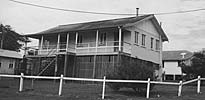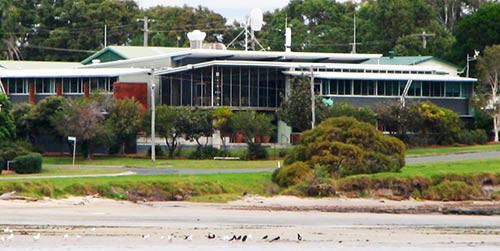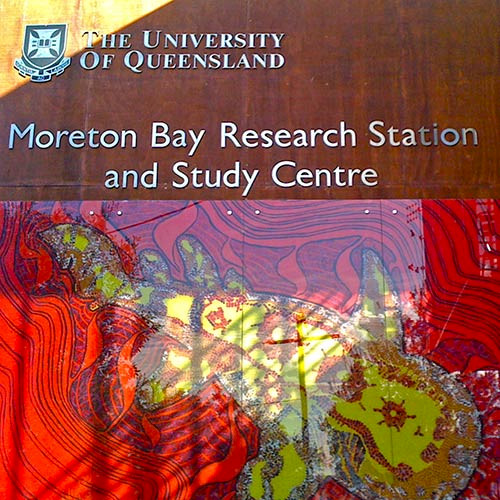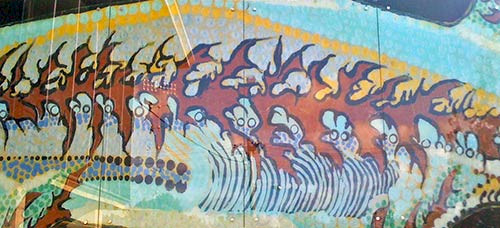Moreton Bay Research Station
Bill Dennison ·When I arrived at the University of Queensland in 1992, someone in the Botany Department mentioned that there was a research station on Stradbroke Island. I had already borrowed the CSIRO boat to scout around Moreton Bay and realized that a research station at Straddie would be a wonderful place to base a field campaign. Since it took an hour to get from the university to Cleveland, and then another hour to drive the boat across the bay to the vast seagrass meadows on the Amity, Moreton and Wanga Wallen Banks, half the day was used up commuting. By being based on Stradbroke Island, we could duck out and collect samples and be back in the lab in minutes. And having accommodation adjacent to the lab allowed us to work, eat and sleep without going anywhere.

The original "Stradbroke Island Research Station" was a Queenslander house on stilts which served as the laboratory, a long dormitory building with a wide veranda, and a separate kitchen/dining building. The laboratory also had a small bedroom with bunks and the space underneath the house became a good storage area and 'wet lab'. There was no real driveway, just a grassy lawn where you drove and parked vehicles. The part-time caretaker was a local woman from Dunwich, and when the station started getting more use, she retired and the caretaker job was given to John Gerke. John was the husband of the Stradbroke Island nurse who ran the clinic which was next door neighbor to the research station. John was always improving the research station using the meager resources he had available, and he was close by whenever we had a question or a problem. It was also handy having the nurse to patch up the cuts and scrapes that the students inevitably came up with.
The first field trip was originally going to be a small handful of Marine Botany graduate students, but word got out and twenty students turned up, eager to help out. This began a tradition of the Marine Botany group organizing a couple of weeks at the station every summer and during school breaks to mount intensive field campaigns with a couple of dozen people. We rostered the cooking until the group size got too big, and then we had a phase of employing people to cook, eventually going to a caterer. We even had to find additional accommodation during busy periods and occasionally had people in tents outside.
The station did not have a boat, so we would bring our Marine Botany boat, named Warrajamba after the aboriginal rainbow serpent. Eventually, the Zoology Department purchased a boat and we would also bring it along. The station did not have any lab equipment, so we brought everything that we needed. John Gerke helped scavenge equipment from the university, and we would always be on the lookout for whatever was being retired from teaching or research labs.
Drs. Jack Greenwood and Craig Johnson from the Zoology Department created the School of Marine Studies and hired Dr. Ian Tibbetts to be its Executive Director. The research stations came under the School of Marine Studies. Craig ended up moving to the University of Tasmania in Hobart, so it fell upon Jack and Ian to raise money for a new station. They successfully convinced the university, the Port of Brisbane and the mining company (CRL at the time) to put up enough money to remove the old station and build a brand new one. Jack and Ian adopted a very wise strategy of building the largest facility that the money could buy, and not worrying about equipping it at the outset. It was so empty at first that we called it a bowling alley, but visiting the station over a decade later, it is bursting with equipment and the bowling alley is a distant memory.

The architects realized that the prime aspect of the property to emphasize was the northwest corner, overlooking One Mile Harbour. They built two levels, upstairs for researcher and downstairs for teaching groups, both with balconies and views. They also designed open passageways to allow natural breezes and large eaves to provide shade. The newly constructed station was an instant hit, and the Marine Botany group was the first to use the new station.
John Gerke and his wife moved to Hervey Bay and the new station managers were hired from Heron Island, Kevin and Kath Townsend. Kath did her PhD on fish at Heron Island with Ian Tibbetts and Kevin ran the maintenance department at the Heron Island Research Station. Kath has developed an active research program on sharks and rays. Kath and Kevin have been successfully building up the capacity of the station, and between fifteen and twenty thousand visitors use the station annually. Visitors include university students from all over Australia and overseas. That is up from several hundred visitors when I started using the station. Kathy and Kevin have also become active members of the Dunwich community, facilitated by their two cute little girls who attend the local school.

The new, renamed Moreton Bay Research Station has state of the art equipment, a recirculating seawater system, a good little library with access to the University of Queensland library system, accommodation for a nearly a hundred people, a commercial kitchen, and, most importantly, competent and friendly staff who facilitate both research and teaching seven days a week. The station provides an annual open house and they get hundreds of people turning up to learn about what is happening. Another feature that Kath and Kev started was to invite local artists to display their art at the station. Their art, in addition to Prof. Justin Marshall’s colorful and artistic photographs of fish scales enhances the station.

One of my favorite views in the whole world is looking out over the eastern banks of Moreton Bay with Moreton Island in the distance. The research station provides that wonderful view and I recall having many scientific discussions about the Bay while enjoying the view. I have always enjoyed getting to know more about the Bay and always enjoyed watching the birds and the boats as the Bay constantly changes character with the sun, stars and wind affecting the water surface. This magnificent view helps fuel the passion that scientists studying the Bay obtain--we all want to preserve The juxtaposition of a laboratory in such a beautiful setting leads to the acquisition of both knowledge and passion.
About the author
Bill Dennison

Dr. Bill Dennison is a Professor of Marine Science and Vice President for Science Application at the University of Maryland Center for Environmental Science.
Next Post > Flood newsletter on seagrasses, turtles and dugongs
Comments
-
John Gehrke 15 years ago
Bill, You have brought back many fond memories. I have not seen the new completed station, however, perhaps one day.
-
David Graham 2 years ago
Bill, I too remember those days and the old station with fond memories. The old caretaker was known as Shirley the cat woman because she turned up to feed the resident cats at the station. And the station did have a small boat with a hand pulled trailer. Pulling the trailer across the sand flats at low tide after a day on the water was a real chore!

